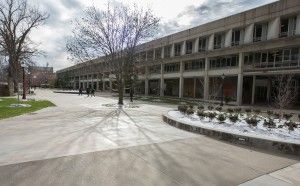Balancing Act

January 16, 2013
Faner project highlights budget, priority questions
Enrollment is down, money’s so tight faculty have been laid off and the university is spending more than a million dollars to build a pedestrian mall outside Faner Hall.
To some, that appears to be a case of misguided priorities. But administrators say campus safety and appearance is important, and they point out that the money for construction projects comes from accounts that cannot be tapped for other uses.
Advertisement
Money for the Faner project stems from the plant fund, which is state- appropriated each year for campus repairs and improvements, Chancellor Rita Cheng said.
She said the $1.3 million project will increase safety in the area and create a stronger sense of campus unity.
According to the project’s proposal, the construction will contribute to the university’s “sense of space” and serve as a stage for ceremonial, social and educational functions.
The pedestrian mall will be built on the north side of the new Student Services Building, which is scheduled to be completed in June of this year. The path will extend to the north pedestrian overpass and lead up to Parkinson Hall, said Todd Sigler, director of the Department of Public Safety.
The first phase of mall upgrades that began at Faner Drive south and continued to the Student Center was completed in summer 2012. The second phase is scheduled to begin this spring, according to the December Board of Trustees proposal.
Sigler said the goal of the pedestrian mall is to create an environment people will want to visit and socialize with other university community members, along with feeling safe while they walk through at night.
Cheng said the mall’s construction area has broken sidewalks, overgrown plants and is very dark at night, which makes it unsafe for pedestrians.
Advertisement*
Sigler said the area has consistently been one of concern during campus safety walks, which are yearly efforts to identify unsafe areas.
“Because this area has almost no lighting, many students have expressed concern when walking through it,” he said. “Therefore, the upgrading process is actually long overdue and much-needed.”
Sigler said the area will have emergency phones available for faculty and students to use and Light- Emitting Diode lighting, which has become popular on other campuses. The lights are brighter and the bulbs last longer, which Sigler said could improve safety.
The plan is to migrate other areas of campus to this style of lighting as well since prices for the lights have become more feasible, Sigler said.
According to the December proposal, other improvements include constructed seating areas and refreshed landscaping with raised planting areas and new plantings.
Still, not everyone is convinced the money is being well-spent. With the state’s share of the university budget in decline each year, job vacancies across campus and two non-tenure- track faculty laid off in the fall semester, some find the sight of new construction jarring.
“While we understand there may be accounting differences between capital and operational budgets, it is a shame when our state
and administrators find money for concrete even as teachers are laid off,” said Anita Barrett, president of the Non-Tenure Track Faculty Association.
Randy Hughes, associate mathematics professor and former Faculty Association president, which represents tenured faculty, said he is concerned the university might not have its priorities in the correct order.
Hughes said, although construction and upgrades are important, a university’s mission is to instruct students on becoming successful.
“While I understand that there is a divided budget and money is coming in from different sources and is meant for specific departments, the decisions made that affect the campus as a whole should not de-emphasize the mission of the university,” he said.
However, campus priorities have become a
constant discussion amongst faculty and students because of several faculty layoffs this year.
Hughes said even though he has noticed a steady enrollment decrease, tenured faculty has declined much faster. He said there are many teachers retiring and not as many hired to fill those positions.
Seventy faculty members retired in summer 2012. However, as of September 2012 only 40 of those positions had been filled.
SIU then took a 971-student decline from the fall 2011 semester, according to 10-day enrollment numbers released in August 2012.
Then two non-tenure track faculty members received notification Nov. 30 that they would be laid off and their last day was Jan. 13.
“Institutions should adjust to their capacity, therefore we should have adequate levels of staffing,”
Hughes said. “While recruitment is a top priority, ensuring the success of our students should be as well.”
Cheng said the construction and improvements made to campus are as important as other administrations priorities.
“We are continuing the recruitment process for faculty, and the average teacher to student ratio remains 15 to one. The importance of education as well as safety of our campus are both very important,” she said.
Hughes said SIU has a reputation of admitting students who have little chance to succeed.
“I can honestly say SIU faculty does a lot to help students succeed,” he said. “Therefore, I think it’s safe to say that faculty plays an important role here.”
Advertisement








